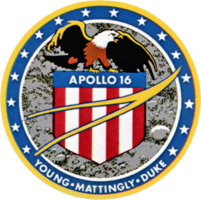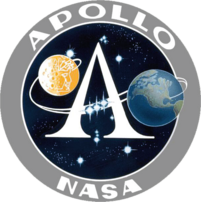Apollo 16
| Apollo 16 | |||||
Mission insignia |
|||||
| Mission statistics[1] | |||||
|---|---|---|---|---|---|
| Mission name | Apollo 16 | ||||
| Command Module | CM-113 callsign Casper mass 30,395 kg |
||||
| Service Module | SM-113 | ||||
| Lunar Module | LM-11 callsign Orion mass 16,445 kg |
||||
| Crew size | 3 | ||||
| Booster | Saturn V SA-511 | ||||
| Launch pad | LC 39A Kennedy Space Center Florida, USA |
||||
| Launch date | April 16, 1972 17:54:00 UTC |
||||
| Lunar landing April 21, 1972 02:23:35 UTC Descartes Highlands 8° 58' 22.84" S 15° 30' 0.68" E (based on the IAU Mean Earth Polar Axis coordinate system) |
|||||
| Lunar EVA duration | First 07:11:02 Second 07:23:09 Third 05:40:03 Total 20:14:14 |
||||
| Lunar surface time | 2 d 23 h 02 m 13 s | ||||
| Lunar Roving Vehicle | LRV-2 | ||||
| CMP EVA duration | 01:23:42 | ||||
| Lunar sample mass | 95.71 kg (211 lb) | ||||
| Total CSM time in lunar orbit | 5 d 05 h 49 m 32 s | ||||
| Landing | April 27, 1972 19:45:05 UTC |
||||
| Mission duration | 11 d 01 h 51 m 05 s | ||||
Crew photo Left to right: Mattingly, Young, Duke |
|||||
| Related missions | |||||
|
|||||

Apollo 16 was the tenth manned mission in the Apollo program and the fifth mission to land on the Moon, the first to land in the highlands area. The mission was launched on April 16, 1972, and concluded on April 27. It was a J-class mission, featuring a Lunar Rover and it brought back 94.7 kg of lunar samples. It included three lunar EVA: 7.2 hours, 7.4 hours, 5.7 hours and one trans-earth EVA of 1.4.
The Apollo 16 subsatellite was launched from the CSM while it was in lunar orbit. The subsatellite carried out experiments on magnetic fields and solar particles. It was launched April 24, 1972 at 21:56:09 UTC and orbited the Moon for 34 days and 425 revolutions. It had a mass of 80 lb (36.3 kg) and consisted of a central cylinder and three 1.5 m booms.
En route to the moon, the Apollo 16 astronauts took several photos of Earth. One of which was with North America in the background, with much of the northern portion of the continent under extensive cloud cover.
Despite a malfunction in the Command Module which almost aborted the lunar landing, Apollo 16 landed successfully in the Descartes Highlands on April 21.
Contents |
Crew
Number in parentheses indicates number of spaceflights by each individual prior to and including this mission.
- John W. Young (4) - Commander
- T. Kenneth Mattingly Jr. (1) - Command Module Pilot
- Charles M. Duke Jr. (1) - Lunar Module Pilot
Young and Duke served as the backup crew to Apollo 13; Mattingly was slated as the Apollo 13 command module pilot until being pulled from the mission due to his exposure to rubella by Duke.
Backup crew
- Fred W. Haise, Jr - Commander
- Stuart A. Roosa - Command Module Pilot
- Edgar D. Mitchell - Lunar Module Pilot
Although not officially announced, the original backup crew consisted of Haise (CDR), William R. Pogue (CMP) and Gerald Carr (LMP) who were targeted for the prime crew assignment on Apollo 19.[2] However, after the widely expected cancellations of Apollo 18 and Apollo 19 were finalized in September 1970 it meant that this crew would not rotate to a lunar mission as planned. Subsequently, Roosa and Mitchell were recycled to serve as members of the backup crew after returning from Apollo 14 while Pogue and Carr were re-assigned to the Skylab program where they later flew on Skylab 4.
Support crew
- Philip K. Chapman
- Anthony W. England
- Henry W. Hartsfield, Jr
- Robert F. Overmyer
Mission parameters
- Mass:
- Launch mass: 2,921,005 kg
- Total spacecraft: 46,782 kg
- CSM mass: 30,354 kg, of which CM was 5840 kg, SM 24,514 kg
- LM mass: transposition and docking 36,252 lb (16,444 kg), separation for landing 36,743 lb (16,666 kg), ascent stage at lunar liftoff 10,949 lb (4966 kg)
- Earth orbits: 3 before leaving for Moon, about one on return
- Lunar orbits: 64
- Perigee: 166.7 km
- Apogee: 176.0 km
- Inclination: 32.542°
- Period: 87.85 min
- Perilune: 107.6 km
- Apolune: 315.4 km
- Inclination: 168°
- Period: 120 min
- Landing Site: 8.97301° S - 15.50019° E or
8° 58' 22.84" S - 15° 30' 0.68" E
LM - CSM docking
- Undocked: April 20, 1972 - 18:07:31 UTC
- Docked: April 24, 1972 - 03:35:18 UTC
EVAs
- Young and Duke - EVA 1
- EVA 1 Start: April 21, 1972, 16:47:28 UTC
- EVA 1 End: April 21, 23:58:40 UTC
- Duration: 7 hours, 11 minutes, 02 seconds
- Young and Duke - EVA 2
- EVA 2 Start: April 22, 1972, 16:33:35 UTC
- EVA 2 End: April 22, 23:56:44 UTC
- Duration: 7 hours, 23 minutes, 09 seconds
- Young and Duke - EVA 3
- EVA 3 Start: April 23, 1972, 15:25:28 UTC
- EVA 3 End: April 23, 21:05:31 UTC
- Duration: 5 hours, 40 minutes, 03 seconds
- Mattingly (Duke - Stand up) - Transearth EVA 4
- EVA 4 Start: April 25, 1972, 20:33:46 UTC
- EVA 4 End: April 25, 21:57:28 UTC
- Duration: 1 hour, 23 minutes, 42 seconds
Mattingly's EVA was only the second trans-earth EVA ever and was used to bring in film from exterior cameras and conduct an experiment on microbial survival.
The splashdown point was 0 deg 43 min S, 156 deg 13 min W, 215 miles (350 km) southeast of Christmas Island and 5 km (3 mi) from the recovery ship USS Ticonderoga.
Mission highlights

A malfunction in a backup yaw gimbal servo loop in the main propulsion system of the CSM Casper caused concerns about firing the engine to adjust the CSM's lunar orbit, and nearly caused the Moon landing to be scrubbed. After a delayed first landing attempt, it was determined that the malfunction presented relatively little risk, and Young and Duke (who were already undocked, and flying LM Orion when the problem occurred) were permitted to land on the Moon. However, the mission was shortened by a day (reducing the time in orbit around the Moon after the LM left the Moon and docked with the CSM), as a safety measure.
Young and Duke spent three days exploring the Descartes highland region, while Mattingly circled overhead in Casper. This was the only one of the six Apollo landings to target the lunar highlands. The astronauts discovered that what was thought to have been a region of volcanism was actually a region full of impact-formed rocks (breccias). Their collection of returned specimens included an 25 pound (11.7 kg) chunk that was the largest single rock returned by the Apollo astronauts[3] (nicknamed "Big Muley" after Bill Muehlberger, principal investigator for the mission's geology activities[4]). The scientific results of Apollo 16 caused planetary geologists to revise previous interpretations of the lunar highlands, concluding that meteorite impacts were the dominant agent in shaping the moon's ancient surfaces.
The Apollo 16 astronauts also conducted performance tests with the lunar rover, at one time getting up to a top speed of eleven miles per hour (eighteen kilometers per hour), which still stands as the record speed for any wheeled vehicle on the Moon (listed as such in the Guinness Book of Records).

Relics
The Casper command module is currently at the U.S. Space & Rocket Center, in Huntsville, Alabama. The lunar module ascent stage separated 24 April 1972 but a loss of attitude control rendered it out of control. It orbited the Moon for about a year. Its impact site on the Moon is unknown.

Charles Duke donated some relics, including a lunar map, to Kennesaw State University in Kennesaw, Georgia. He also left a plastic-encased photo portrait of his family on the moon.
Mission insignia
The circular patch featured an eagle with wings outstretched, perched atop a red, white, and blue shield, over a lunar surface. The vector symbol from the NASA logo was placed on top of the shield, and then across the shield were written the words APOLLO 16. The artwork was bordered in white, with a blue band carrying 16 stars and the crew names. There was a gold border. The patch was designed by NASA artist Barbara Matelski.
Quotes
"I mean, I haven't eaten this much citrus fruit in 20 years! And I'll tell you one thing, in another 12 fucking days, I ain't never eating any more," John Young, reacting to stomach problems caused by drinking extra orange juice (to prevent an electrolyte deficiency identified in crew of Apollo 15). [5]
Media
See also
- Extra-vehicular activity
- List of spacewalks
- Splashdown
- List of artificial objects on the Moon
- Google Moon
References
- ↑ Richard W. Orloff. "Apollo by the Numbers: A Statistical Reference (SP-4029)". NASA.
- ↑ Donald K. Slayton, "Deke!" (New York: Forge, 1994), 262
- ↑ Lunar Sample Facility Tour - Pristine Sample Laboratory Display Cabinet
- ↑ Apollo 16 Video Library
- ↑ Chaikin, Andrew: "A Man on the Moon: The Voyages of the Apollo Astronauts", page 476. Penguin, 1998
- NASA NSSDC Master Catalog
- APOLLO BY THE NUMBERS: A Statistical Reference by Richard W. Orloff (NASA)
- The Apollo Spacecraft: A Chronology
- Apollo Program Summary Report
- Lattimer, Dick (1985). 'All We Did was Fly to the Moon. Whispering Eagle Press. ISBN 0-9611228-0-3.
- Apollo 16 Characteristics - SP-4012 NASA HISTORICAL DATA BOOK
- NASA Manned Spacecraft Center (1972), 'Apollo 16 Technical Air-to-Ground Voice Transcription'
External links
- ON THE MOON WITH APOLLO 16 A guidebook to the Descartes Region by Gene Simmons, NASA, 1972.
- Apollo 16 entry in Encyclopedia Astronautica
- U.S. Space & Rocket Center Museum (location of Apollo 16 command module)
- (Part 1) NASA film on the Apollo 16 mission downloadable from www.archive.org The Internet Archive)
- (Part 2) NASA film on the Apollo 16 mission downloadable from www.archive.org The Internet Archive)
- Apollo Lunar Surface VR Panoramas QTVR panoramas
- Apollo 16 Science Experiments
- Audio recording of Apollo 16 landing
- Apollo 16 television transmissions ApolloTV.net Video
|
|||||||
